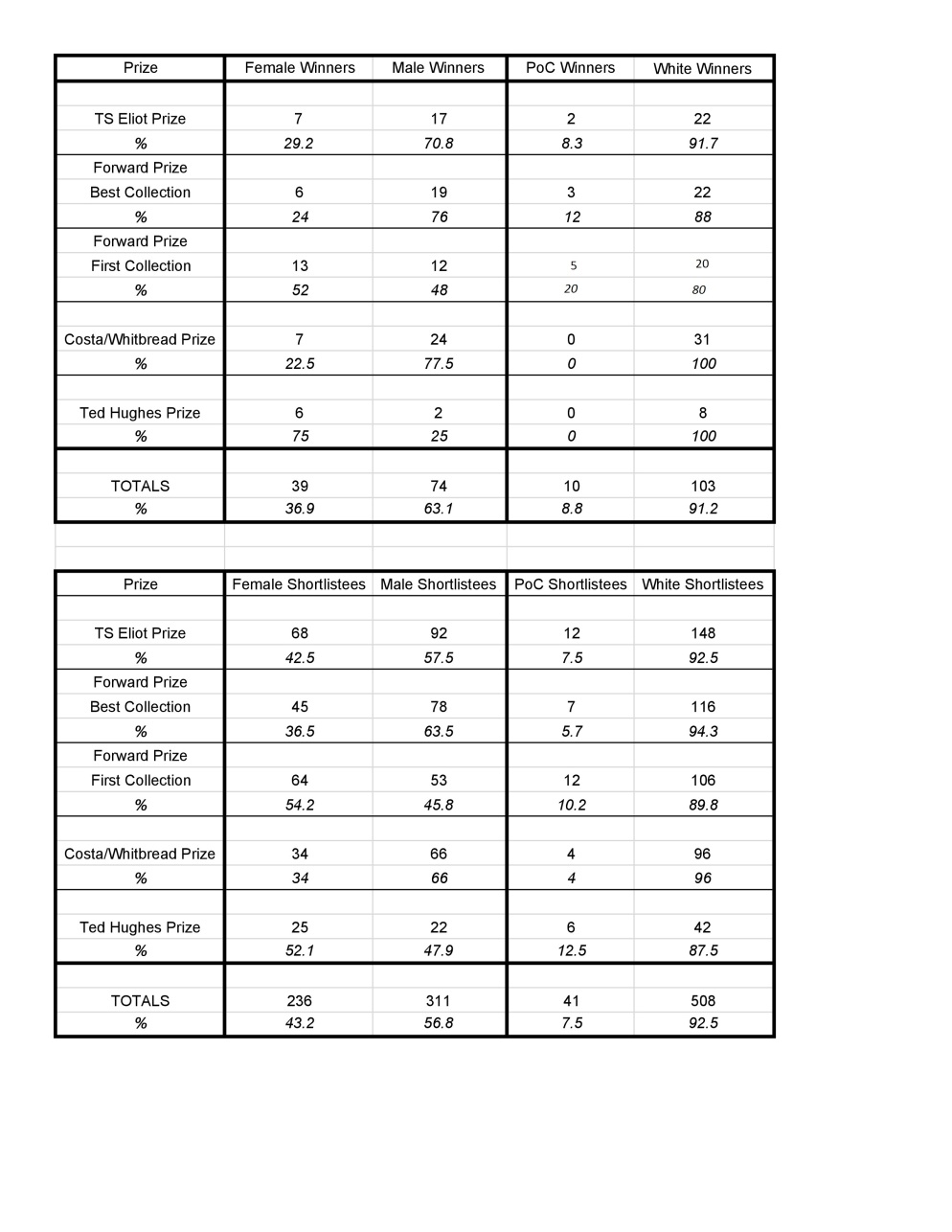[NB: This report was first published in the Brixton Review of Books (No. 6, Summer 2019). It is reprinted with kind permission of the BRB editors Michael Caines, Tess Davidson, and Alice Wadsworth. I’m a big fan of the magazine, it publishes excellent people, and you can subscribe on the BRB website.]
In the six years between 2011 and 2016, British and Irish poetry magazines and newspapers published critical work by Black, Asian and Minority Ethnic (BAME) critics 130 times. That was just 3.7 per cent of the total number of such critical pieces for those years. In the two years since the launch of the Ledbury Emerging Poetry Critics scheme in 2017, BAME critics have appeared in the same publications 115 times, 8.3 per cent of the total. The Ledbury scheme has desmonstrably spearheaded this rapid, vital change; but these successes must be taken in context as part of a fight for an inclusive poetry culture dating back many years.
In 2005, Bernardine Evaristo prompted Arts Council England to investigate the lack of BAME poets publishing in these islands. With the additional support of other British arts councils and the London writer development agency Spread the Word, the subsequently published report, Free Verse, discovered that under than 1 per cent of books published by major presses were by BAME poets. The Complete Works programme mentored its first ten BAME poets in 2010, and eight years later, that figure stands above 16 per cent; even Faber has begun to redress its institutional whiteness, publishing Ishion Hutchinson’s House of Lords and Commons in 2017, Zaffar Kunial’s Us in 2018, and Mary Jean Chan’s Flèche this year. As Evaristo argues, however, poetry in this country in the 1980s and 90s was far more receptive to BAME poets, as the prominence of John Agard, Grace Nichols, Valerie Bloom, Benjamin Zephaniah, E. A. Markham and Linton Kwesi Johnson demonstrated.[1] What Evaristo identified was not just a contemporary failure but a significant recession.
Besides the poets, what about the people who write about poetry? In my initial study, “The State of Poetry Criticism”[2], I found that between April 2015 and May 2017, only 4.4 per cent of reviews across seven major poetry platforms were written by BAME critics. Yet there are some signs of change. In 2015, for example, only ten articles by BAME critics were published, 1.3 per cent of the year’s total; the corresponding figure for 2018 was sixty-two, 8.5 per cent of the year’s total.
There have also been negative responses to what, in historical terms, might feel like a sudden change. In the past year, Michael Schmidt, publisher of Carcanet Poetry, editor of PN Review and mentor in The Complete Works, has written a series of editorials in PN Review in which he decries “identity politics”, describes a recent willingness to hold prominent white male artists responsible for their actions as “censorship”[3], and relates his own feeling of being “silenced” and “anathematised” for being “a white male in the vale of years with what used to be regarded as a good education”.[4] Like Peter Riley before him[5], Schmidt argues that a prescriptiveness imposed on work by BAME poets by publishers and critics is a manner of “censorship”. Both Riley and Schmidt omit the fact that publishers and critics remain overwhelmingly white, and that their decision to police the borders of BAME poets’ work maintains the centrality and cultural influence of white poets, critics, publishers and editors, not to mention the curators of “good educations”. In both cases, senior white figures instrumentalize their ostensible concern for BAME poets’ wellbeing to defend their own positions of power. Riley condemned Claudia Rankine for “parading the wound” in Citizen: An American lyric (Rankine won the Forward Prize for which Riley was shortlisted); Schmidt swiftly proceeds to defend the work of Woody Allen and James Levine against “censors”, elevating two (alleged) sexual abusers to the ranks of D. H. Lawrence and Vladimir Nabokov.
As many have noted, to those accustomed to privilege, equality feels like oppression, and as a series of studies have shown, we remain far from equal. Programmes like The Complete Works and the Ledbury Emerging Poetry Critics have made tangible inroads for a still relatively small number of BAME poets and critics, but even this slight shift represents significant change.
*
Resuming the work of my survey published online in 2017, I had two main questions: whose poetry is reviewed? and whose reviews are commissioned and published? The set on critical writing now includes data from twenty-eight magazines dating from January 2011 to December 2018, a total of 4,866 articles reviewing 7,711 books. Those magazines are: Acumen, Antiphon Poetry, Bare Fiction, The Compass, The Guardian, Gutter, Ink Sweat & Tears, The Interpreter’s House, London Grip, the London Review of Books, Magma, Modern Poetry in Translation, Mslexia, The North, Oxford Poetry, PN Review, Poetry Ireland Review, Poetry London, Poetry Review, The Poetry School, Poetry Salzburg Review, Poetry Wales, Sabotage Reviews, Southwords, The Stinging Fly, Stride, the Times Literary Supplement and The Wolf.
There are obvious limitations on the data I have collected. The figures do not cover other important intersections of cultural exclusion such as class, disability, education or sexuality, and on race and gender they are unsophisticated. Regarding race, my terms are unsatisfactorily binary; this is, in part, due to greater accuracy often being impossible without self-reporting. As many writers have noted[6], neither BAME nor Person of Colour are ideal terms; both involve significant erasure of cultural, racial and national experiences and traditions. I hope that the outcomes of this study justify the employment of reductive terminology. The 2011 census reported that people self-identifying as Black, Asian or minority ethnicity comprised 12.9 per cent of the total UK population, 4.9 per cent in Ireland. While I do not believe in the imposition of arbitrary quotas, it is, at the very least, useful to have such a basic demographic benchmark in mind when trying to determine what representative inclusion might look like on a purely statistical level.[7]
Of 4,866 articles published between January 2011 and December 2018, 245 were written by BAME critics, 5.03 per cent of the total. Of the twenty-six magazines and newspapers in the study still regularly publishing, only five surpassed this basic figure: Poetry Review (14.5 per cent), Poetry London (18.3 per cent), Oxford Poetry (18.5 per cent), The Poetry School (20.4 per cent) and Modern Poetry in Translation (21.4 per cent). Nine magazines published 1 per cent or fewer BAME critics.
Particular attention is due to the London Review of Books. The LRB has published seventy articles by thirty-three critics covering eighty-six books since January 2011. Every one of their critics is white, 83 per cent are men, and every one of the books reviewed is by a white poet. The magazine publishes poems with greater regularity: six of the 388 poems published since January 2011 are by BAME poets (1.5 per cent). 70.6 per cent of all poems published are by men, including twenty-eight by August Kleinzahler, twenty-seven by John Burnside, twenty-two by David Harsent and nineteen by Frederick Seidel; these four poets account for 24.7 per cent of all poems published in the magazine during those eight years.
The country’s other major literary journal, the Times Literary Supplement, has a similar record. Though one of only five platforms to publish more than twenty articles by BAME critics, this constitutes 3.6 per cent of its total. Contrary to trends observed elsewhere in the data, most of these articles were published before 2016: nineteen before and five after. Much like the LRB, the TLS published just seven poems by BAME poets (1.3 per cent), and 72.2 per cent by men. Before December 2018, the last BAME poet to publish in the TLS was Imtiaz Dharker, on February 5, 2016.
Much like the TLS, PN Review’s publication of BAME reviewers has also regressed sharply. The magazine published thirteen articles by BAME critics between January 2011 and October 2013; there then follows a period of three years and four months, or twenty consecutive issues, without a single review by a BAME critic. Since March 2017, there have been just three articles published by BAME critics, and an excellent regular column by Vahni Capildeo does not cover for the magazine’s failures elsewhere. Despite this, PN Review has been a consistent publisher of BAME poets throughout the data set: 206 of their 2,100 published poems between 2011 and 2018 are by BAME poets (9.8 per cent, well above the national average of 8.3 per cent).
More encouraging examples do exist. In Poetry London, for example, twenty-one articles by BAME critics were published between 2011 and 2016, 11.9 per cent of the total for those years. In 2017–18, the magazine has published nineteen articles by BAME critics, 29.7 per cent of their total. An even more remarkable change has happened at Poetry Review: between 2011 and 2016, the magazine published fourteen articles by BAME critics (6.1 per cent); between 2017 and 2018, that number has more than doubled to thirty, a full 40 per cent of its total in the past two years. These increases are consistent with the magazines’ publication of poems: Poetry London’s publication of BAME poets rose from 7 per cent in 2011–16 to 16.2 per cent in 2017–8; Poetry Review’s publication of BAME poets rose from 16.1 per cent to 28.2 per cent over the same periods.
The Complete Works and the Ledbury Emerging Poetry Critics programmes have played a huge role in recent changes. Similar to The Complete Works’ mentorship of poets, the Ledbury scheme aims to provide BAME critics with training and opportunities to develop their craft. Of the 245 articles by BAME critics in the data set, 117 were written by fellows of one or both programmes, 47.8 per cent of the total. This increase has, perhaps unsurprisingly, coincided with an increase in critical attention toward BAME poets, and with BAME poets publishing in higher numbers. In total, 627 of the 7,711 books reviewed in the data set were written by BAME poets (8.13 per cent). The figure fluctuated around 6 per cent between 2011 and 2016, with a peak in 2016 (7.7 per cent) and a trough in 2013 (4.9 per cent). In the past two years, this figure has doubled, to 12.9 per cent in 2017 and 13.1 per cent in 2018. Though I do not have exact figures, it seems that more books by BAME poets are being published year on year, particularly by small presses such as Nine Arches (in 2019 the press will have published collections by Theresa Lola, Ian Humphreys, Roy McFarlane and Tom Sastry) and Penned in the Margins (Anthony Anaxagorou, Raymond Antrobus). Veteran publishers such as Carcanet (Jane Yeh, Vahni Capildeo and Kei Miller) and Bloodaxe (Chen Chen, Vidyan Ravinthiran and Legna Rodriguez Iglesias), meanwhile, continue their good work with more established poets. There is a close relationship between BAME poets’ access to major publishers and BAME critics’ access to major journals: one enables, requires, demands the other.
While there have been significant advances in the reception of BAME poets and critics in recent years, it remains the case that these small steps are supported by a small number of institutions and individuals, and the possibility of backlash and regression is significant. For instance, the publication of poems by BAME poets reached record highs of 10.8 per cent in 2016 and 10.9% in 2017 but fell to 8.4 per cent in 2018. There have also been numerous instances of high-profile white journalists responding to work by BAME poets with ignorance (for example, Kate Kellaway’s description of “oriental poise”[8] in Sarah Howe’s Loop of Jade) or outright hostility, as in the September 2018 issue of Acumen, whose front cover asked, “Has poetry been hijacked?”[9] The author of the essay in question, Paul Gittins, refers to “a Guardian journalist” before quoting a piece by the poet and academic Sandeep Parmar.[10] Gittins refers to Parmar using male pronouns, before condemning attempts to decolonize literary culture as “threatening the very identity of poetry”. Gittins conflates the “identity” of poetry as a medium with that of white poets, and frames this country’s white critics (95 per cent of the total), white poets (92 per cent) and white prizewinners (88 per cent) as an embattled minority. He also follows Riley and Schmidt in claiming that his concerns are primarily for the welfare of BAME poets, describing Parmar’s article as “condescending” for suggesting “they apparently need a favourable quota system to enter the prize lists”. Parmar’s article makes no such proposal, and Gittins’s memory seems short: no BAME poet had ever won the Forward Prize for Best Collection prior to 2014, and the T. S. Eliot Prize only once before 2015; almost two-thirds of all BAME shortlistings have been in the past five years. White authors repeatedly position ourselves as central, unmarked, natural occupants of cultural space, even as concerned guardians of BAME poets, however much our supposed advocacy rejects even the slightest structural change. It is possible, indeed vital, for white critics to spend time and energy questioning our biases, educating ourselves about our colonial histories and how we continue to benefit from them, and listening at least as carefully to work by BAME poets as we do to white poets, showing respect to the literary canons and traditions in which they situate themselves. Part of this work, however, must include raising up BAME voices ahead of our own: the Ledbury Emerging Poetry Critics programme has demonstrated an abundance of extraordinarily capable candidates.
[1] Evaristo, Free Verse Report, 2007, 3.
[2] Dave Coates, “The State of Poetry Criticism”, DavePoems (May 29, 2017). https://davepoems.wordpress.com/2017/05/29/the-state-of-poetry-criticism/
[3] Editorial, PN Review 242 (July–Aug 2019), https://www.pnreview.co.uk/cgi-bin/scribe?item_id=10244
[4] Editorial, PN Review 245 (Jan–Feb 2019), https://www.pnreview.co.uk/cgi-bin/scribe?item_id=10385
[5] Peter Riley, “Vahni Capildeo”, Fortnightly Review, April 12, 2016, http://fortnightlyreview.co.uk/2016/04/vahni-capildeo/
[6] See, for example, Courttia Newland, Nikesh Shukla et al, “Beyond PoC and BAME: The terminology we use to define ourselves”, Media Diversified, July 16, 2016, https://mediadiversified.org/2016/07/16/past-poc-and-bame-the-terminology-we-use-to-define-ourselves/
[7] Office of National Statistics, https://www.ons.gov.uk/census/2011census
[8] Kate Kellaway, “The Best Poetry Books of 2015”, Observer, December 8 2015, https://www.theguardian.com/books/2015/dec/08/best-poetry-books-2015-clive-james-claudia-rankine
[9] Paul Gittins, “Hijacking Poetry”, Acumen 92 (September 2018). The use of the highly loaded term “hijacking” in reference to BAME people should not be overlooked.
[10] Sandeep Parmar, “Why the TS Eliot prize shortlist hails a return to the status quo”, The Guardian, 20 Oct 2017, https://www.theguardian.com/books/booksblog/2017/oct/20/why-the-ts-eliot-prize-shortlist-hails-a-return-to-the-status-quo








